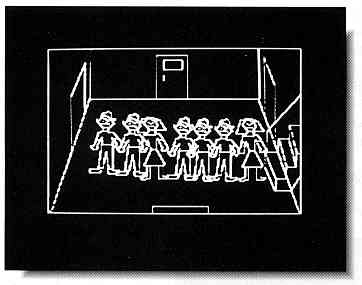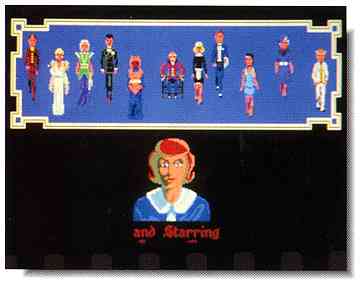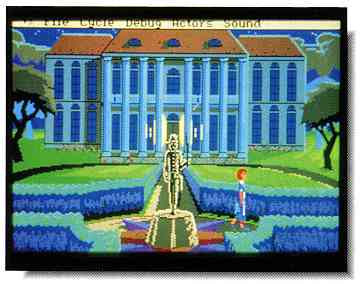An Interview with Sierra On-Line's Roberta Williams
BY TOM BYRON, START EDITOR
King Graham, Roger Wilco, Larry Laugher - these are just few of the characters that have made Sierra On-Line one of the most successful software houses ever. And if these names are familiar, chances are you've heard the name Roberta Williams, too. She and her husband Ken started the whole graphic-adventure, role-playing phenomenon that made Sierra an overnight hit. In the following interview, Roberta talks about Sierra On-Line's past, present and future.
Within the computer-game world, Roberta Williams is somewhat of a legend - she almost single-handedly started the graphic adventure genre. And along with her husband Ken, she founded Sierra On-Line, one of the most successful and fastest growing software companies in the entertainment industry.
Listening to Roberta is like reading a book on the history of personal computers because she's been there from the very beginning. Every game Roberta has written - and she's written quite a few - has turned into a classic. And some, like her King's Quest series, have attained permanent cult status.
Roberta was in San Francisco recently to promote her new game Colonel's Bequest, which is now available for the ST. I took this opportunity to learn more about Sierra On-Line - it's beginnings and its present and future directions.
Beginnings
What were the events that led up to the birth of Sierra On-Line?
It all started back in 1979. I was a housewife with two kids and my husband Ken was a programmer at a company where he worked on huge IBM mainframe machines. It was around that time that the Apple computer was hitting the homes and Ken immediately saw a lot of possiblities with the machine. He was fascinated by the idea that you could have a computer in your home because he was so used to working with computers that filled entire rooms.
The first thing I did with the computer was to play a text adventure called Original Adventure - it was also known as Colossal Cave. I immediately became addicted to it and I didn't stop playing until I made it all the way through.
After I finished Adventure, I wanted to play more of the same type of games. I shopped around and couldn't find anything other than some Scott Adams games from Adventure International. That was it. I had looked everywhere and if this was all there was, then there was a need here and maybe I could fill it. So I wrote and designed a murder mystery called Mystery House.
The real birth of Sierra On-Line and the graphic adventure game was around February of 1980 at a restaurant in Simi Valley [Calif.]. During dinner I told Ken about my new game but he didn't want to listen -he thought it was silly. I insisted and he finally heard me out.
As we talked, Ken realized I had something here and we talked about it and we thought 'why don't we add pictures to ours?' All the others were text-based.

Sierra On-Line's Roberta
Williams is somewhat of a legend within
the computer-game world.
In the past 10 years, she's written 15
games and is responsible
for such classics as the King's Quest
and Space Quest series.
But there was a problem - there were no graphics programs available at the time. We figured we'd need at least 60 pictures in this game.
So, we shopped around and found a little store in Thousand Oaks [Calif.] that sold something called a Versawriter. It was a board of thick plexiglass that had an arm-like device with an electronic eye at the tip. The idea was that you put a piece of paper on the board and then you moved the arm around to draw onto the computer. Of course there was no software available for our computer to read the Versawriter, so Ken wrote the necessary program.
I figured out what these graphics would look like. I decided that the players would always be facing north, east or west, never behind them. Ken figured out how to access the Versawriter and we put Mystery House together. It was an instant hit and the rest is history.
So what came after Mystery House?
Wizard and the Princess, Mission Asteroid, Time Zone, then Dark Crystal with Jim Henson, then Black Cauldron and Mickey's Space Adventure with Disney - the list goes on.
So you've written or concieved most of the Sierra On-Line graphic adventures?
To this day that's probably true. I've done about 15 games in 10 years.
Had you had any writing experience before Mystery House?
No, but I had always been a reader and I had always been a story teller. Of course, I didn't realize how good I was until I started doing these games.
You've actually covered some of this already, but it's worth going over again: what are the steps you take in putting a game together?

This is a screen shot
from Roberta Williams' Mystery House,
the first graphic adventure
ever made for a personal computer
and the launch pad for
Sierra On-Line's phenomenal success.

Graphic adventures have
come a long way since the days
of Mystery House. This
is the opening scene from Roberta's
latest creation, Colonel's
Bequest. You play Laura Bow and
on a weekend trip to
a friend's uncle's estate, you've got to
find out who's murdering
everyone.

Colonel's Bequest is
set in New Orleans, circa 1925. Sierra
went to great pains to
make sure the fashions and music
fit the times.
The first thing you do - which is what I'm going to be doing real soon with King's Quest V - is to figure out what the story is, what it is you're doing, who you are, what your quest or your goal is, where you are and why you're there, etc. That's probably one of the hardest parts, that's where the actual writing comes in.
You said that in Mystery House you drew about 60 separate pictures -what is that up to now on an average game?
Well it used to be that each place was one picture. The average was between 80 and 100 pictures. But now we're going away from the one-picture, one-place format. Now there are less places but more scenes. For instance, you might have a room but you'd have varied perspectives. Colonel's Bequest has something like 75 actual places you can be which in the old days would translate into 75 pictures. But now, the pictures plus the scenes are probably up to 150.
Has Sierra On-Line ever been approached by any movie studios for film rights to your games?
We have been approached to make King's Quest into a Saturday-morning cartoon but we don't think we'll do that because we think Saturday-morning cartoons look cheap. We want to maintain a quality image.
We have also been approached by two movie studios to do Leisure Suit Larry. We're currently in negotiations to see if we want to do anything there. Of course, we don't want to rush into anything. All of our characters are very precious to us and we don't want someone else to have the rights to them and do a bad job. We've also been approached to do board games and books for King's Quest.
Colonel's Bequest
Tell me about your new game colonel's Bequest.
It's the first in a line of games we're calling 'The Laura Bow Mysteries.' In other words, if this game does well, you won't be seeing a Colonel's Bequest II. It'll be another, completely different story within the series.
Colonel's Bequest itself is somewhat difficult to explain because it's so different from anything we've ever done at Sierra and from anything anyone else has ever done, for that matter. It's a murder mystery so it takes us back to our roots.
The main character is a woman, a Nancy Drew type. You're a young college student in 1925 New Orleans and your father is a detective on the New Orleans police force. It's very dated - we went to great pains to copy the costumes and the overall atmosphere of the times.
As the story goes, you've been invited by a college friend to her rich uncle's isolated estate for a weekend family reunion. It's important that you're not a member of the family because your character needs to be able to stand apart from the main action.
The prologue - I'm pretty famous for these opening cartoons -establishes the story line and goes something like this:
You and your friend get to her uncle's and in front of you is this old bayou estate with lots of trees and Spanish moss. On the porch of the house is this crotchety Colonel in a wheelchair and the various family members who he's gathered there for the weekend. That night he announces the intentions for his will in which he plans to divide his estate equally. If one of them should die before he does, then that part of the inheritance will go into the pot and be redistributed. As soon as he finishes his announcement, he goes to bed and that's where the game really begins.
Soon, one by one, the family members begin to die and you discover they're being murdered.
So part of the quest is to find out why these people are being killed?
This is where it gets confusing because there is no 'quest' per Se. Colonel's Bequest is very much an interactive story. One of the directions Ken and I see Sierra going is in interactive entertainment - stories. Of course it can't just be a story, it also has to be a game, you have to feel like you're playing it but you also want to be interested in the story.
I see - it's kind of like reading a novel except you're taking a more active role because you're always unraveling the story.
Right. Most adventure games are very puzzle oriented - you solve this puzzle and then go on to the next puzzle until you get to the end of the game to accomplish your goal or quest.
Colonel's Bequest isn't like that. There is no real goal - you're an innocent thrust into a situation where suddenly all these people are dying and things are happening and you can talk to them, spy on them, tell them things, figure out who's having affairs with whom and you're just going along with the events of the story. There are puzzles in the game, but it's not puzzle oriented.
You do have to find out who's doing the killing and why. But, you're not a detective, it's not like DejaVu, for instance, where you actually are a detective.
One question that came up with Colonel's Bequest was 'can you scare someone with a computer game?' I didn't believe it could, but we found that it did scare some of our beta testers. It's very suspenseful.
I noticed that the main character is a woman. You've done this in quite a few of your other games.
If a woman fits the story then the main character will be a woman, if a man fits it then it'll be a man. I'm not going to be constrained by the idea that it has to be a man because this is a man's industry. Or that it has to be a woman because I'm a woman in a man's industry and I'm a feminist. Nothing like that.
Are many of Sierra's fans women?
We probably have a higher market share of women than any other computer game maker. Interestingly enough, when a woman is the main character, we don't lose any of our male audience, but we gain more women.
Roberta Williams on the ST Market and Future Directions for Sierra On-Line
What's the general feeling about the ST at Sierra?
A year or so ago we were in a situation where Sierra was percieved as an IBM company. But we don't want this, we never wanted this. We want to be seen as a computer entertainment company - not tied to any one machine.
A lot of people mistakenly think that our games are just IBM conversions. But when Ken first sat down to write the code for Mystery House, he wanted to write a special language that just did graphic adventure games, one that we could use over and over. The result was the Sierra Creative Interpreter. SCI is a virtual machine language which means that it will work on any machine. SCI takes advantages of the special things the ST can do that, say, the IBMs can't, like fading. Each machine format has its own version of SCI. It's true that our games appear on the IBMs first but that's because of its higher user base, not because they're better machines. Our games are never IBM conversions.
What about games in general? With new technology like CD-ROM and optical read/write drives you're getting a lot more information on a single disk. Where do you see all that going?
At Sierra we want to do so much that we have to hold ourselves back. Our games are pushing 10 disks now and to have 10 disks is holding ourselves back. You'd be amazed at how much we have to cut out of a game to make it fit on 10 disks. So optical and CD-ROM obviously make sense for Sierra. It's an area we are seriously looking into.
How about a hint at some new games coming from Sierra?
Nineteen Ninety is our year of sequels: King's Quest V will be out - I think I'm going to bring back King Graham as the hero; Space Quest IV, etc. And of course Leisure Suit Larry III - we can't forget Larry - was just released.
PRODUCTS MENTIONED
Colonel's Bequest. $59.95. Sierra On-Line, Inc., P.O. Box 485, Coarsegold, CA 93614